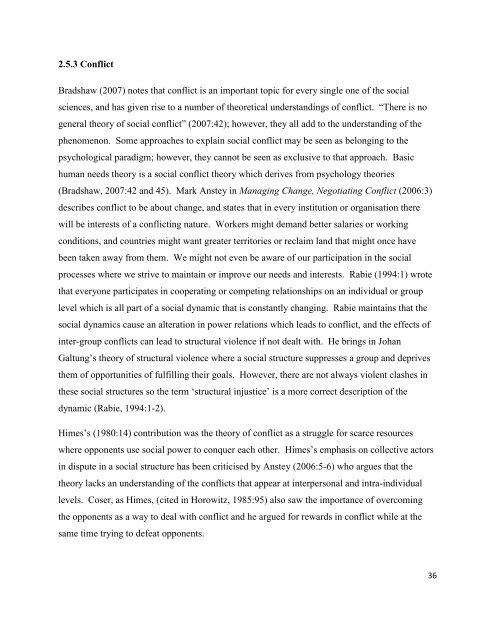Guro Lauvland Bjorknes.pdf - NMMU
Guro Lauvland Bjorknes.pdf - NMMU
Guro Lauvland Bjorknes.pdf - NMMU
You also want an ePaper? Increase the reach of your titles
YUMPU automatically turns print PDFs into web optimized ePapers that Google loves.
2.5.3 Conflict<br />
Bradshaw (2007) notes that conflict is an important topic for every single one of the social<br />
sciences, and has given rise to a number of theoretical understandings of conflict. “There is no<br />
general theory of social conflict” (2007:42); however, they all add to the understanding of the<br />
phenomenon. Some approaches to explain social conflict may be seen as belonging to the<br />
psychological paradigm; however, they cannot be seen as exclusive to that approach. Basic<br />
human needs theory is a social conflict theory which derives from psychology theories<br />
(Bradshaw, 2007:42 and 45). Mark Anstey in Managing Change, Negotiating Conflict (2006:3)<br />
describes conflict to be about change, and states that in every institution or organisation there<br />
will be interests of a conflicting nature. Workers might demand better salaries or working<br />
conditions, and countries might want greater territories or reclaim land that might once have<br />
been taken away from them. We might not even be aware of our participation in the social<br />
processes where we strive to maintain or improve our needs and interests. Rabie (1994:1) wrote<br />
that everyone participates in cooperating or competing relationships on an individual or group<br />
level which is all part of a social dynamic that is constantly changing. Rabie maintains that the<br />
social dynamics cause an alteration in power relations which leads to conflict, and the effects of<br />
inter-group conflicts can lead to structural violence if not dealt with. He brings in Johan<br />
Galtung‟s theory of structural violence where a social structure suppresses a group and deprives<br />
them of opportunities of fulfilling their goals. However, there are not always violent clashes in<br />
these social structures so the term „structural injustice‟ is a more correct description of the<br />
dynamic (Rabie, 1994:1-2).<br />
Himes‟s (1980:14) contribution was the theory of conflict as a struggle for scarce resources<br />
where opponents use social power to conquer each other. Himes‟s emphasis on collective actors<br />
in dispute in a social structure has been criticised by Anstey (2006:5-6) who argues that the<br />
theory lacks an understanding of the conflicts that appear at interpersonal and intra-individual<br />
levels. Coser, as Himes, (cited in Horowitz, 1985:95) also saw the importance of overcoming<br />
the opponents as a way to deal with conflict and he argued for rewards in conflict while at the<br />
same time trying to defeat opponents.<br />
36
















